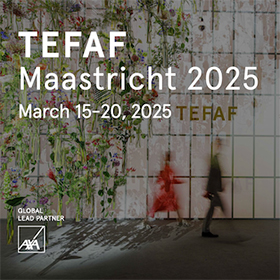
MARCH 15 – MARCH 20, 2025
Tefaf is unique and exceptional, and it is for this very special occasion that I have brought together my finest sculptures from the 18th, 19th and 20th centuries. Let us start by considering the exquisite bust by Nicolas-François Gillet, Hébé; particularly notable for the virtuosity of his delicate marble sculptures, Nicolas François Gillet, who spent a long time in Russia during the Age of Enlightenment, here revisits Antiquity with voluptuous suppleness, paving the way for the idealised sculpture of the neo-classical period.. The highlight of this selection is a magnificent and extremely rare quadruple-patinated bronze by Jean-Baptiste Carpeaux, Pourquoi naître esclave n°1 (1868). Tied-up and restrained, the bust remains completely immobile, while the neck, face and hair violently escape its shackles. Here, the sculptor expresses himself on a topical subject close to his heart: the abolition of slavery. Less than twenty examples are recorded over two decades, in bronze or terracotta in the two dimensions offered, with the stamp of the Carpeaux estate. Only three other “No. 1” bronzes (in the larger size) are known to exist in American museums, making this a major discovery for Carpeaux’s work. As luck would have it, I was able to acquire another sculpture by the same artist, Le Prince impérial et son chien Néro (1865), this time in aluminum bronze, cast by Paul Morin. Only two examples of the Imperial Prince in cast aluminum by Paul Morin, gold medallist at the 1867 Universal Exhibition, are known to exist: one, unsigned and without a foundry mark, is still in Paul Morin’s family, and the other, our signed example, was made for Empress Eugénie. This is a prestigious historical souvenir that enriches our 19th-century sculpture section. Another fine provenance distinguishes a small neo-renaissance walnut cabinet probably designed by Pierre Manguin, the architect of the Hôtel de la Païva, and adorned with four electroplating plaques by Jules Dalou, variants of the decorative plaques he made for the library doors of this celebrated mansion. Meissonier’s famous Voyageur, a posthumous cast, like all the bronze editions of his wax models, admirably conveys the painful struggle of rider and mount advancing against the blowing wind.
Another great name in sculpture is Edgar Degas, represented here by a Danseuse ajustant l’épaulette de son corsage. This great painter rivaled the greatest sculptors. Our cast possesses all the characteristics of fine Hébrard casts, in particular the beautiful light-brown patina that reveals the soft modeling of the original wax. Another discovery is an original terracotta by Labatut, Saint Jérôme. This unjustly overlooked artist was able to convey all the tension of meditation on a simple skull, said to be the seat of the soul, in this inward-looking figure. Of comparable intensity is Jean Escoula‘s bronze La Douleur (circa 1890). The precise modelling of the face and the particular twist of the neck give this head its striking power. The broadly treated hair and taut, hollowed muscles, creating harsh contrasts, recall contemporary experiments by Rodin. Here again, bronze casts of this model remain rare, with only two known examples, ours and the one in the Musée de Valenciennes.
Neo-baroque and Art Nouveau, Raoul Larche‘s sculpture was highly appreciated in its day for its fluid lines and swirling forms, notably his various representations of the dancer Loïe Fuller, whose veils he rendered superbly. We present a masterpiece by this artist, Les Violettes (1899), undoubtedly the artist’s first Art Nouveau sculptural manifesto.
Let us not forget the animal sculptors; many of them are on display: Charles Artus, Mateo Hernandez, Alfred-Auguste Janniot, Marcel Lémar… A unique piece is a Capybara in Burgundy marble by an artist of Lithuanian origin, Anton Joutsaytis, who took refuge at La Ruche. He was part of the first generation of artists who would later become known as the Ecole de Paris, and whose works are also extremely rare. It is in the company of this friendly animal that I would like to close this brief overview, which I hope will surprise collectors and curators attending this superb fair. Nicolas Bourriaud
